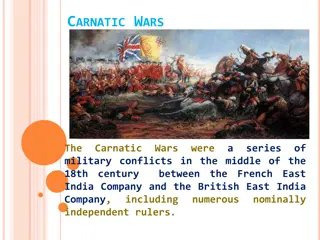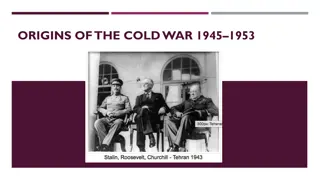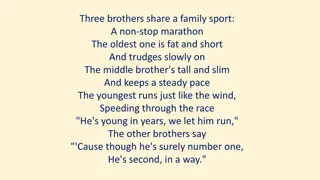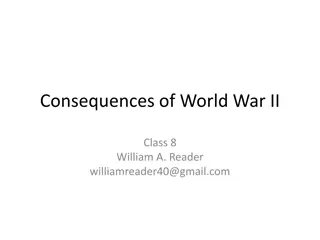The First Carnatic War: A Historical Overview
Fought between English and French forces in the Carnatic region of Southern India from 1746 to 1748, the First Carnatic War was a significant conflict in colonial history. Led by key figures like Governor-General Dupleix and Major Stringer Lawrence, the war resulted in an inconclusive outcome with the Treaty of Aix-la-Chapelle in 1748. The course of the war showcased the strategic maneuvers of both sides, with implications for European influence in India and the return of territories like Madras.
Download Presentation

Please find below an Image/Link to download the presentation.
The content on the website is provided AS IS for your information and personal use only. It may not be sold, licensed, or shared on other websites without obtaining consent from the author.If you encounter any issues during the download, it is possible that the publisher has removed the file from their server.
You are allowed to download the files provided on this website for personal or commercial use, subject to the condition that they are used lawfully. All files are the property of their respective owners.
The content on the website is provided AS IS for your information and personal use only. It may not be sold, licensed, or shared on other websites without obtaining consent from the author.
E N D
Presentation Transcript
First Carnatic War Notes R. DEVI., M.A., M.Phil., Assistant Professor Department of History Bon Secours College for Women, Thanjavur
Introduction Fought between: English and French forces. People involved: Governor-General), Major Stringer Lawrence (British), Anwaruddin Khan (Nawab of the Carnatic). When: 1746 1748 Where: Carnatic region, Southern India Result: Inconclusive. Joseph Fran ois Dupleix (French
COURSE OF THE FIRST CARNATIC WAR COURSE OF THE FIRST CARNATIC WAR France and Britain were on opposite sides of the camp at the War of Austrian Succession that had broken out in Europe in 1740. This Anglo-French rivalry led to their trading companies in India vying with each other for supremacy. The French Governor of Pondicherry Dupleix had raised an army of Indian sepoys under French officers in India. The French East India Company was nationalized in 1720 and France had imperialistic designs on India. In 1745, there was a naval attack on a French fleet by Britain in which even Pondicherry in danger. Dupleix, along with additional French troops from Mauritius defended against this attack and captured Madras, which had been controlled by the English. The English made another attack on Pondicherry but instead faced a heavy loss. The English sought help from the Nawab of Carnatic (Arcot)Anwaruddin Khan.
The Nawab asked the French to return Madras to the British. Dupleix tried convincing the Nawab unsuccessfully that Madras would be handed over to him at a later stage. Then, the Nawab sent a huge army to fight the French forces. This army was defeated by the relatively small number of French forces in Mylapore (in modern-day Chennai) in 1746. This exposed the weakness of the armies of the Indian rulers vis- -vis the efficiently trained armies of the European powers. The war ended in 1748 with the Treaty of Aix-la-Chapelle also called Treaty ofAachen.
EFFECTS OF THE FIRST CARNATIC WAR EFFECTS OF THE FIRST CARNATIC WAR Madras was given back to the English in exchange for Louisburg in NorthAmerica to France. Dupleix understood the superiority of the European armies who used this advantage to influence Indian princes and establish French hegemony in South India


![❤[PDF]⚡ Civil War Talks: Further Reminiscences of George S. Bernard and His Fel](/thumb/20551/pdf-civil-war-talks-further-reminiscences-of-george-s-bernard-and-his-fel.jpg)




















